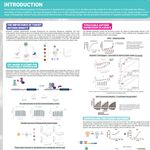Product Manager, Custom Molecular Biology Products Management Group, Thermo Fisher Scientific
BIOGRAPHY

MAY 19, 2020 8:00 AM PDT
Looking Beyond PCR: Isothermal Amplification
Sponsored by: Thermo Fisher Scientific - Invitrogen
Speakers
-
Remigijus Skirgaila, Ph.D.
Lead R&D Manager, NGS Library Preparation and Protein In Vitro Evolution Group, Thermo Fisher ScientificBIOGRAPHY
Event Date & Time
DATE: May 19, 2020
TIME: 8:00am PT, 11:00am ET
Abstract
Limited sample material resulting in insufficient DNA input is a common hurdle for downstream analysis. This problem can be solved using a variety of methods, including techniques that utilize isothermal amplification. Several methods of isothermal amplification are available – each with advantages and challenges. In this webinar, we will cover two methods, WGA and LAMP, that are commonly used in today’s laboratories.
Whole genome amplification (WGA) is a valuable tool to produce large quantities of genomic DNA from limited samples or even single cells. Using a WGA technique called multiple strand displacement amplification (MDA), we will show how the challenges of low DNA input can be overcome using a next generation enzyme, EquiPhi29 DNA Polymerase, an engineered phi29 DNA Polymerase mutant. We will demonstrate that uniform amplification can be obtained from single cells, while leveraging time-saving protocols.
Another method of isothermal amplification, loop-mediated isothermal amplification (LAMP), is a rapid method for detecting low amounts of DNA. This technique eliminates the need for a thermal cycler and is increasingly used in rugged field settings for the rapid diagnosis of plant pathogens or infectious disease agents like malaria, Zika, or tuberculosis. We will show how LAMP may be used in specific molecular diagnostics applications.
Learning Objectives:
- Understand how the challenges of amplification from low input DNA, including single cells, can be overcome
- Discover why more researchers are using a next generation enzyme, EquiPhi29 DNA Polymerase, to obtain uniform DNA amplification by MDA
- Learn about the utility of LAMP for molecular diagnostic assay development
Webinars will be available for unlimited on-demand viewing after live event.
LabRoots is approved as a provider of continuing education programs in the clinical laboratory sciences by the ASCLS P.A.C.E. ® Program. By attending this webinar, you can earn 1 Continuing Education credit once you have viewed the webinar in its entirety.
You May Also Like
APR 02, 2025 | 11:00 AM
Join this year's poster presenters in the Poster Hall during the Poster Networking Hour, Wednesday, September 20th, from 10:00 AM –11:00 AM PDT , to chat live about their posters a...
APR 21, 2025 | 1:00 PM
C.E. CREDITS
Routine coagulation assays are widely performed in laboratories and provide valuable information to the patient’s overall clinical picture. It’s important for laboratorians to kn...
Speaker:
Malissa S Norfolk, MBA, PMP, MLS(ASCP)ᶜᵐSHᶜᵐ
FEB 25, 2025 | 1:00 PM
C.E. CREDITS
Quality efforts in the clinical laboratory are always under the microscope- a hyper-focus for laboratorians from start to finish. Recognizing the external factors that affect hemostasis test...
Speaker:
Rae Kerlin, BS, MLS (ASCP), NCA
MAR 19, 2025 | 11:30 AM
Join this year's poster presenters in the Poster Hall during the Poster Networking Hour, Wednesday, March 5th, from 10:00 –11:00 AM PDT , to chat...
DEC 10, 2024 | 9:00 AM
To-date, proteomic analysis has been severely limited in scale and resolution. Analyzing protein samples using an intact, single-molecule approach holds th...
Loading Comments...
Please update your information
Certificate of Attendance
Thank you for choosing Labroots. Please note that a Certificate of Attendance does NOT count towards Continuing Education Credits.
DOWNLOAD CERTIFICATE
DOWNLOAD CERTIFICATE
You must watch the entire webinar to receive your certificate of attendance.
You must attend the event before receiving your certificate of attendance.
You must register for the event first.
Certificate is no longer available for this event.
You must be logged in to retrieve your certificate.
Finish Registering
Attendees





